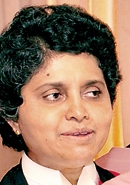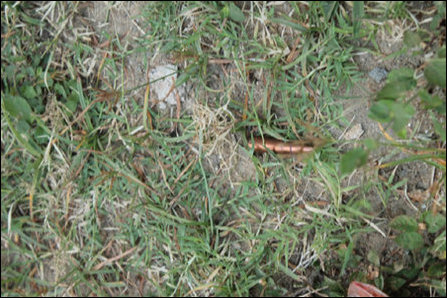BY KITHSIRI WIJESINGHE-12 APRIL 2013
When the Sri Lankan government wanted to give away free laptops to journalists, many seemed happy. But Lasantha Ruhunuge differed. As the president of the largest media trade union in the island – Sri Lanka Working Journalists Association – he had overwhelming reasons to do so.
‘What we need is not free laptops, but freedom to write and justice’ he wrote to the media ministry.
![]()
‘Tell us who killed our colleagues. Bring the perpetrators to book. That can strengthen us, but free laptops cannot.’
The consequences could have been deadly. B
![]()
ut he prefers to shrug them off. “When you know that you cannot write without risking your life, it’s important to stick to your principles’ he says.
“For me, it was simply a matter of principles.”
As the news editor of the Sinhala weekly ‘Ravaya’, he keeps trying to push the boundaries. But heading a prominent journalists union can still be more challenging in a country where scores of media workers are killed with impunity.
Lasantha spoke to JDS on media freedom, right to dissent and the state of democracy in Sri Lanka.
The excerpts from the interview, follow:
A deficiency of critical media discourse seems to be convention in Sri Lanka. What are the features that enable this apparent silence and co-operation of mass media whilst the state carries on with undemocratic and oppressive policies?
I believe that two main factors have affected Sri lanka’s media society with regard to this situation.
One is the policy of repressing media practiced by the government. It has led to journalists been conditioned to carry on with their media practice without being critical or challenging state activity. Accordingly, Sri Lankan media are maintained merely as business houses only.
The other is business networks loyal to President Rajapaksa and quite intimate with the government acquiring and operating media institutions. Some mainstream media institutions are owned by ruling party parliamentarians and ministers. The ownership of several other media in receipt of outlets is held by heads of state establishments. Some editors have been appointed as government advisors.
In this context we cannot anticipate an independent and critical media culture. In media outlets operated by those loyal to the president and the government as well as those in receipt of government privileges, some journalists are forced to be pen pushers against their will in order to save their life and livelihood.
Identifying a single media institution that either questions, challenges or is critical about government action, is almost impossible. It is evident that many media institutions and journalist conduct their activity in compromise and keeping out of conflict with the government. Some compete to be in the good books of powers to be. This is a travesty as well as a saddening situation.
So, the majority of journalists indulging in a media practice in compromise with the regime, is it due to institutional restraints or a tradition of cooperation that has become the hegemonic convention within the society?
It is true that the government keeps a band of obedient journalists by bestowing paybacks upon them. However, it needs to be mentioned that there is another facet that has not caught attention. A journalist in Sri Lanka is a professional with no workers’ rights. Even in relation to SAARC standards, we are at the bottom on rights. Many journalists do not receive a wage that befits their work. Whatever the danger faced in the line of duty, there is no liability insurance. Welfare facilities are almost non-existent. A majority of media outlets do not provide the equipment necessary for coverage. These conditions easily pave the way for the government to poach on many journalists. It is mainly by providing an assorted range of incentives.
![]()
There is no established procedure in Sri Lanka to recruit journalists or promote them to editorial boards. Mostly, these happen either on personal affiliations or on loyalty to the ruling party. My personal opinion is that to say journalists speak to uphold people’s rights, is a myth while they themselves do not stand for the right of their profession or freedom.
In no other country has the government media accreditation identity card become the main tool of journalism. But, in Sri Lanka the situation is totally different. No media institution provides their journalists with an official press accreditation card. In its place, journalists are forced to obtain the government media accreditation card. This has led to a state where the government media accreditation card has become the main criteria to identify a journalist in Sri Lanka. The country’s mass media has arrived at a juncture where it questions a journalist’s reputation on the basis of a government credential.
It is true that those involved in journalism in Sri Lanka are only a group of titular reporters, not proper investigative journalists. Today, the country has neither a pack of scribes who investigate, question the actions of powers that be and reveal it to the people, nor such practice.
Of course, there are a handful of journalists who endeavour to alter this sorry situation. Yet, they have to engage in a struggle that is massive as well as dreadful. On the one hand they have to face the repressive environment set up by the government through numerous laws and regulations in addition to violence. On the other, it is the constraints imposed by the pro-government stance of media institutes and their owners.
Isn’t it possible to transform this situation by the active intervention of media workers’ organisations?
Many members of media organisations in Sri Lanka also do not take any attempt to change this situation. Especially, a majority of journalists and their organisations in the country have not identified the importance of engaging in a media practice that falls in line with international standards and regulations. They are opposed to quality journalism. The reason they indicate is the fear to be in the bad books of the rulers. In addition they fear that such journalism would lead to unnecessary friction and retaliations. That is why the membership of the International Federation of Journalists (IFJ) has fallen to the hands of those in Sri Lanka who are distanced from the media field. This is not only a disaster but also a state where we need to be ashamed of ourselves.
My belief is that those who were at the helm of the media field as well as those who led media organisations have to answer for this deterioration. We are aware of how they responded in crucial moments in history, when efforts were initiated for change. Actually, in terrifying circumstances we got along as if nothing has ever happened. In some occasions, we simply confined ourselves to protest demonstrations.
The editor of a mainstream journal was killed in broad daylight. Did the newspaper editors in Sri Lanka have the guts to stop their publications for one day? Has the media ever been able to stage a protest in unison? Why? Because we are not properly organised. Media bosses only welcome those who can be kept under their control. Those who criticise their political ideology and the ruling party are kicked out. In recent times, how many editors, editorial board members were thrown out within hours? Who is opposed to changing this situation? Many are looking forward not to be part of a collective struggle against this tyranny, but to jump to the seat vacated by the colleague who was kicked out.
Isn’t it right to say that those quick to take the initiative of branding those who bring to light issues about human rights and media freedom in Sri Lanka , as traitors, are mainly journalists themselves?
I agree that this is an argument that cannot be easily brushed aside. Nevertheless, as stated earlier, one would have to accept the reality of media ownership in Sri Lanka. Today, the media in the land is governed by one person alone. No news item that goes against his politics is given any space. Therefore, journalists in those institutes are able to do only one duty: To earn their livelihood in a manner that would help save their lives. That is why journalists within and without the country who question government deeds are named as traitors, in addition to the spreading of a doctrine that calls not only for the annihilation of those journalists, but also their loved ones. It is true that this handful of journalists is posing a challenge to the government. That has led to the government carrying on a vicious campaign with falsified statements and cries for their destruction.
In addition, we are aware that the government has ushered in a number of oppressive laws in order to rob us of the right to information. Sri Lanka is a land where the accurate information is percieved as a crime. So called representatives of the people sitting in parliament defeated the bill on Right to Information with no qualms. Information was censored in a massive scale with the assistance of draconic legislation including the Prevention of Terrorism Act (PTA) and Emergency Regulations (ER). These are not seen as problems by a nation dazed by the delusion of Sinhala patriotism.
During the the 80s and 90s, Journals identified as the alternative stream came into existence as a response against extreme and destructive realities. Can we today detect any evidence of them losing their alternate content?
The alternative media practice we witnessed in the 80s and 90s is not a pragmatic thing anymore. Not a single media outlet remains committed to a peoples ideology. Each media institution has its own power strategy. Journalists are confined to staying away from getting into dispute with the government and writing feature articles that only carry humour without substance. Instead of questioning the anti-democratic and dictatorial nature of the government, Sri Lanka’s media and journalists are reduced to safeguarding advertisement revenue and basking in the glory of sitting for a tea party thrown by the ruling elite as an honour.
![]()
In the 80s and 90s the alternative media and a group of such journalists emerge from this soil as an outcome of the massive social catastrophe and its resistance. Today what we see is the turning of a blind eye to the colossal social catastrophe and justifying it while proiding ample space to boastful rhetoric by the ruling elite. However, we have a glint of hope. It is the web sites that perform a role, to a certain extent, that was carried out as an alternative stream. With all their shortcomings, it is a creditable role.
In reporting politically controversial news, do you see a significant distinction between state governed media and those owned by corporates?
The primary practice of media owned by corporate business is to market social disasters. It doesn’t involve any discussion with quality or substance. They do not honour any acceptable norm in journalism. Nonetheless, they are silent about crimes and human rights violations committed by the political authority. The credibility and standard of both the state and corporate owned media is almost non-existent in the sphere of reportage and investigative journalism. It is a waste of time to even talk about quality in state owned media.
In the 80s and the early 90s alternative journals thought to have a clout, came in to being bearing the responsibility of revealing the human rights violations faced by the Sinhala society. But, weren’t the same journals aiding and abetting the atrocities committed in the Tamil dominated areas?
My view is that a majority of those identified as journalists haven’t have fulfilled the basics to serve in that role. An authentic journalist should have the spirit and determination to report and investigate crises and discriminations faced by all nationalities and to question the government on such matters.
What is your view on the attitude of Colombo centric Sinhala and English media concerning difficulties and repression that Tamil journalists have to suffer?
My earlier opinion is valid for some Tamil journalists as well as the Sinhalese. Having said that, it is important to note that there are many predicaments that are is unique to Tamil journalists. We need to acknowledge that. This is solely due to the fact that they are Tamil. Being a Tamil itself is enough to be a target of state oppression. In reporting a story, a place that can be freely covered by a Sinhalese could be out of bounds to a Tamil journalist. We need to keep in mind that the majority of journalists who were subject to violence throughout the recent past are Tamils. Therefore, it should be emphasised that the restriction on news coverage is also based on nationality.
 ‘Tell us who killed our colleagues. Bring the perpetrators to book. That can strengthen us, but free laptops cannot.’
‘Tell us who killed our colleagues. Bring the perpetrators to book. That can strengthen us, but free laptops cannot.’










.jpg) FRIDAY, 12 APRIL 2013
FRIDAY, 12 APRIL 2013

































 Saturday, 13 April 2013
Saturday, 13 April 2013
 Saturday, 13 April 2013
Saturday, 13 April 2013



























